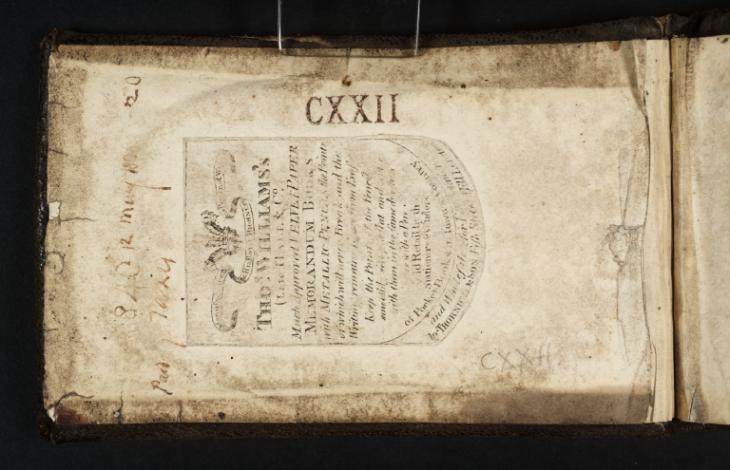Joseph Mallord William Turner Inscription by Turner: A Financial Note 1808
Inside front cover of sketchbook
Joseph Mallord William Turner,
Inscription by Turner: A Financial Note
1808
(Inside front cover of sketchbook)
Joseph Mallord William Turner 1775–1851
Inside Front Cover:
Inscription by Turner: A Financial Note 1808
D40898
Pen and ink on white wove paper, 69 x 112 mm
Inscribed by Turner in pen and ink (see main catalogue entry)
Inscribed with manufacturer’s and stationer’s details on printed label (see main catalogue entry)
Stamped in black ‘CXXII’ top centre
Inscribed in pencil ‘CXXII’ bottom right
Inscribed by Turner in pen and ink (see main catalogue entry)
Inscribed with manufacturer’s and stationer’s details on printed label (see main catalogue entry)
Stamped in black ‘CXXII’ top centre
Inscribed in pencil ‘CXXII’ bottom right
Accepted by the nation as part of the Turner Bequest 1856
References
1909
A.J. Finberg, A Complete Inventory of the Drawings of the Turner Bequest, London 1909, vol.I, p.337, as ‘Inside one cover’, with transcription.
1990
Peter Bower, Turner’s Papers: A Study of the Manufacture, Selection and Use of his Drawing Papers 1787–1820, exhibition catalogue, Tate Gallery, London 1990, p.80 note 3.
With the page turned vertically, Turner has noted the following above the prominent printed label pasted to the centre of the page:
840 12 May 1808 20
Paid [...] Taxes
Paid [...] Taxes
The illegible word is partly rubbed and worn away; it is very short, ending in a letter with a long tail, and may simply be ‘my’. For more on Turner’s finances as set out in the extensive notes in this sketchbook, see the Introduction.
The shield-shaped, engraved label pasted lengthways onto the endpaper is surmounted by a Prince of Wales crown and ostrich feather crest and a scroll inscribed: ‘Manuf[actu]rer to His Royal Highness the P[rinc]e of W[ales]’. The rubbed and partly obliterated text continues:
Thos. Williams’s | (Late Hall & Co.) | Much Approved Velvet Paper | Memorandum Books | with Metallic Pencils the Points | of which will never Break and the | Writing remains s[ecure] from Eras[ure.] | Keep the Point[s] of the Pencil[s] | smoothly scr[aped] flat and [Write] | with them in the same d[irection] | as with a Pen.
[So]ld retail by the | Stationers & Venders | of Pocket Books In Town & Country | and Wholesale for E[xpor]tation | by Thornhill & Son, Fish St[reet] Hill London
Technical notes:
The endpaper is pasted over a simple pocket constructed integrally with the inside of the front cover, into which Turner inserted four loose papers (see the Introduction to the sketchbook). There is dark staining around the outer edges from the leather overlaps. The paper has developed a bulge over the pocket and its contents, causing localised abrasion against the opposite page, particularly affecting the label described above.
This sketchbook is unique in the Turner Bequest in being composed of ‘velvet paper’, with a soft, flock-like surface. The collector Sir Thomas William Holburne (1793–1874) used a similar book for pencil and watercolour sketching in Scotland in 1828 (Holburne Museum, Bath); its label is worded identically except for being headed ‘PHELPS | Original Manufacturer of | HALLS’S | Much Approved ...’ and concluding ‘... Exportation | by J. PHELPS & Co. | At the Manufactory | 27, PATERNOSTER ROW.1 On his 1830s voyage in the Beagle, the scientist Charles Darwin (1809–1882) used six comparable notebooks (classed as ‘Type 5’; English Heritage, Down House), bearing labels without a manufacturer’s name but with similar wording:
VELVET PAPER | MEMORANDUM BOOK. | So prepared as effectually to se- | cure the writing from erasure;– with a METALLIC PENCIL, the point of which | is not liable to break. | The point of the pencil should be kept | smoothly scraped flat & in writing it | should be held in the manner of a common | Pen.2
Of Darwin’s notebooks it has been observed: ‘Although the writing ... looks at first like graphite pencil it is in fact a reaction between the metal of the pencil point and the chemicals with which the paper was treated. This was meant to render the writing indelible.’3 The combination of prepared paper and a stylus is akin to traditional metalpoint drawing techniques.4 Turner appears not to have followed the maker’s instructions, leaving many of his conventional pencil drawings and inscriptions badly rubbed over time, even if this effect was not immediately apparent while he used the book. He also tried watercolour on folio 40 verso (D08347).
Peter Bower has read the last word of the label’s penultimate line as ‘Fourdrinier’ and infers a reference to the Hertfordshire papermakers of that name.5 Although the lower part of the ‘E’ and the subsequent letters are rubbed away, the word does appear to end in ‘tation’, making ‘Exportation’ the likeliest reading, corresponding with the wording of the Holburne example.
Matthew Imms
September 2013
‘The Collection: AR152a: Sir William Holburne’s Scottish sketchbook’, The Holburne Museum, accessed 10 September 2013, http://www.holburne.org/muse/search/item.cfm?MuseumNumber=AR152a .
‘Darwin’s Beagle field notebooks (1831–1836)’, Darwin Online, reproducing and transcribing one label, accessed 10 September 2013, http://darwin-online.org.uk/EditorialIntroductions/Chancellor_fieldNotebooks.html .
How to cite
Matthew Imms, ‘Inscription by Turner: A Financial Note 1808 by Joseph Mallord William Turner’, catalogue entry, September 2013, in David Blayney Brown (ed.), J.M.W. Turner: Sketchbooks, Drawings and Watercolours, Tate Research Publication, September 2014, https://www

